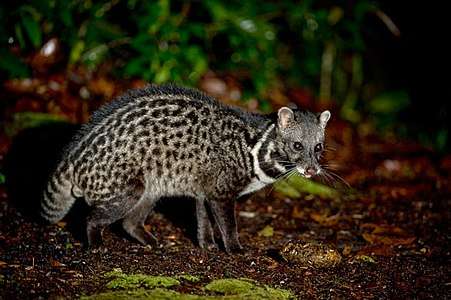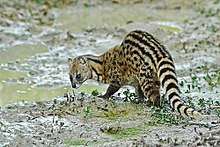List of viverrids
Viverridae is a family of mammals in the order Carnivora, composed mainly of the civets and genets. A member of this family is called a viverrid. They are widespread primarily throughout Africa, India, and southeast Asia, and are found primarily in forests, shrublands, and grasslands, though some species can be found in savannas or wetlands. Three viverrids are classified as endangered, and one, the Malabar large-spotted civet, is classified as critically endangered with a population size of around 200.

The 33 species of Viverridae are split into 14 genera within 4 subfamilies: the 3 civet subfamilies Viverrinae, Hemigalinae, and Paradoxurinae, and the genet subfamily Genettinae. Extinct species have also been placed into Viverrinae, as well as the extinct subfamily Lophocyoninae, though most extinct species have not been categorized into a subfamily. Nearly twenty extinct Viverridae species have been discovered, though due to ongoing research and discoveries the exact number and categorization is not fixed.
Conventions
| IUCN Red List categories | |
|---|---|
| Conservation status | |
| EX | Extinct (0 species) |
| EW | Extinct in the wild (0 species) |
| CR | Critically endangered (1 species) |
| EN | Endangered (3 species) |
| VU | Vulnerable (6 species) |
| NT | Near threatened (3 species) |
| LC | Least concern (18 species) |
| Other categories | |
| DD | Data deficient (2 species) |
| NE | Not evaluated (0 species) |
Conservation status codes listed follow the International Union for Conservation of Nature (IUCN) Red List of Threatened Species. Range maps are provided wherever possible; if a range map is not available, a description of the viverrid's range is provided. Ranges are based on the IUCN red list for that species unless otherwise noted. All extinct species or subspecies listed alongside extant species went extinct after 1500 CE, and are indicated by a dagger symbol "![]()
Classification
The family Viverridae consists of 33 extant species belonging to 14 genera in 4 subfamilies and divided into dozens of extant subspecies. This does not include hybrid species or extinct prehistoric species.
- Subfamily Genettinae
- Subfamily Hemigalinae
- Genus Chrotogale: one species
- Genus Cynogale: one species
- Genus Diplogale: one species
- Genus Hemigalus: one species
- Subfamily Paradoxurinae
- Genus Arctictis: one species
- Genus Arctogalidia: one species
- Genus Macrogalidia: one species
- Genus Paguma: one species
- Genus Paradoxurus: three species
- Subfamily Viverrinae
- Genus Civettictis: one species
- Genus Viverra: four species
- Genus Viverricula: one species
Viverrids
The following classification is based on the taxonomy described by Mammal Species of the World (2005), with augmentation by generally accepted proposals made since using molecular phylogenetic analysis. This includes the promotion of the Prionodontinae subfamily into its own family, and the moving of the Poiana and Genetta genera out of the Viverrinae subfamily into their own Genettinae subfamily. There are several additional proposals which are disputed, such as splitting the golden palm civet into three species or adding three additional species to Genetta, which are not included here.
Subfamily Genettinae
| Common name | Scientific name and subspecies | Range | Size and ecology | IUCN status and estimated population |
|---|---|---|---|---|
| Abyssinian genet
|
G. abyssinica Rüppell, 1836 |
 |
Size: Habitat: Forest, shrubland, and grassland[1] Diet: [1] |
DD
|
| Angolan genet
|
G. angolensis Bocage, 1882 |
 |
Size: Habitat: Savanna[2] Diet: [2] |
LC
|
| Aquatic genet
|
G. piscivora Allen, 1919 |
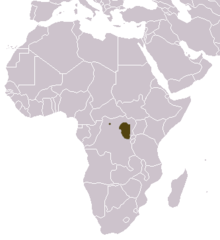 |
Size: Habitat: Forest and inland wetlands[3] Diet: Primarily eats fish[3] |
NT
|
| Bourlon's genet | G. bourloni Gaubert, 2003 |
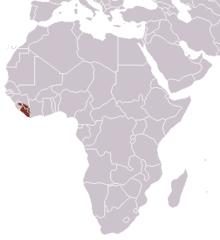 |
Size: Habitat: Forest[4] Diet: [4] |
VU
|
| Cape genet
|
G. tigrina Schreber, 1776 Two subspecies
|
Size: Habitat: Forest, shrubland, and grassland[5] Diet: [5] |
LC
| |
| Common genet
|
G. genetta Linnaeus, 1758 Five subspecies
|
 |
Size: Habitat: Forest, savanna, shrubland, rocky areas (eg. inland cliffs, and mountain peaks)[6] Diet: Primarily eats small mammals, as well as birds, other small vertebrates, insects, and fruit[6] |
LC
|
| Crested servaline genet
|
G. cristata Hayman, 1940 |
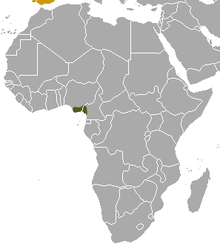 |
Size: Habitat: Forest[7] Diet: [7] |
VU
|
| Giant forest genet
|
G. victoriae Thomas, 1902 |
 |
Size: Habitat: Forest[8] Diet: [8] |
LC
|
| Haussa genet
|
G. thierryi Matschie, 1902 |
 |
Size: Habitat: Forest, savanna, and shrubland[9] Diet: [9] |
LC
|
| Johnston's genet | G. johnstoni Pocock, 1908 |
 |
Size: Habitat: Forest, savanna, and shrubland[10] Diet: [10] |
NT
|
| King genet | G. poensis Waterhouse, 1838 |
 |
Size: Habitat: Forest[11] Diet: [11] |
DD
|
| Pardine genet
|
G. pardina Geoffroy, 1832 |
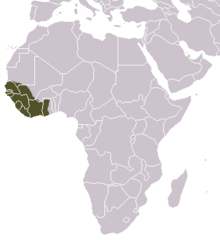 |
Size: Habitat: Forest, savanna, and shrubland[12] Diet: [12] |
LC
|
| Rusty-spotted genet
|
G. maculata Gray, 1830 |
 |
Size: Habitat: Forest, savanna, and shrubland[13] Diet: [13] |
LC
|
| Servaline genet
|
G. servalina Pucheran, 1855 Five subspecies
|
 |
Size: Habitat: Forest and shrubland[14] Diet: [14] |
LC
|
| Common name | Scientific name and subspecies | Range | Size and ecology | IUCN status and estimated population |
|---|---|---|---|---|
| Central African oyan
|
P. richardsonii Thomson, 1842 Two subspecies
|
 |
Size: 33–38 cm (13–15 in) long, plus 35–40 cm (14–16 in) tail[15] Habitat: Forest[16] Diet: [16] |
LC
|
| West African oyan | P. leightoni Pocock, 1908 |
 |
Size: Habitat: Forest[17] Diet: [17] |
VU
|
Subfamily Hemigalinae
| Common name | Scientific name and subspecies | Range | Size and ecology | IUCN status and estimated population |
|---|---|---|---|---|
| Owston's palm civet
|
C. owstoni Thomas, 1912 |
 |
Size: Habitat: Forest and shrubland[18] Diet: Believed to primarily eat earthworms and other invertebrates[18] |
EN
|
| Common name | Scientific name and subspecies | Range | Size and ecology | IUCN status and estimated population |
|---|---|---|---|---|
| Otter civet
|
C. bennettii Gray, 1837 Two subspecies
|
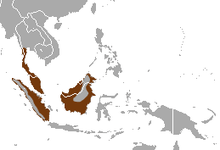 |
Size: Habitat: Forest and inland wetlands[19] Diet: Primarily eats fish, crabs, molluscs, small mammals, and birds[19] |
EN
|
| Common name | Scientific name and subspecies | Range | Size and ecology | IUCN status and estimated population |
|---|---|---|---|---|
| Hose's palm civet
|
D. hosei Thomas, 1892 |
 |
Size: Habitat: Forest[20] Diet: Believed to primarily eat small fish, shrimp, crabs, and frogs as well as insects[20] |
VU
|
| Common name | Scientific name and subspecies | Range | Size and ecology | IUCN status and estimated population |
|---|---|---|---|---|
| Banded palm civet
|
H. derbyanus Gray, 1837 Four subspecies
|
 |
Size: Habitat: Forest[21] Diet: Primarily eats insects[21] |
NT
|
Subfamily Paradoxurinae
| Common name | Scientific name and subspecies | Range | Size and ecology | IUCN status and estimated population |
|---|---|---|---|---|
| Binturong
|
A. binturong Raffles, 1821 Six subspecies
|
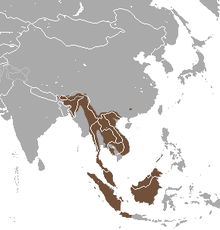 |
Size: 61–96 cm (24–38 in) long, plus 56–89 cm (22–35 in) tail[22] Habitat: Forest[23] Diet: [23] |
VU
|
| Common name | Scientific name and subspecies | Range | Size and ecology | IUCN status and estimated population |
|---|---|---|---|---|
| Small-toothed palm civet
|
A. trivirgata Gray, 1832 Fourteen subspecies
|
 |
Size: 44–60 cm (17–24 in) long, plus 48–66 cm (19–26 in) tail[24] Habitat: Forest[25] Diet: [25] |
LC
|
| Common name | Scientific name and subspecies | Range | Size and ecology | IUCN status and estimated population |
|---|---|---|---|---|
| Sulawesi palm civet
|
M. musschenbroekii Schlegel, 1877 |
 |
Size: Habitat: Forest, shrubland, and grassland[26] Diet: Primarily eats rodents and palm fruit, as well as other small mammals, birds, fruit, and grass[26] |
VU
|
| Common name | Scientific name and subspecies | Range | Size and ecology | IUCN status and estimated population |
|---|---|---|---|---|
| Masked palm civet
|
P. larvata H. Smith, 1827 Sixteen subspecies
|
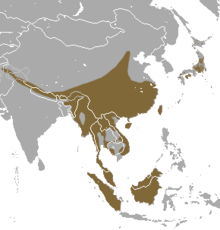 |
Size: 50–76 cm (20–30 in) long, plus 50–64 cm (20–25 in) tail[27] Habitat: Forest and shrubland[28] Diet: Omnivorous; primarily eats fruit[28] |
LC
|
| Common name | Scientific name and subspecies | Range | Size and ecology | IUCN status and estimated population |
|---|---|---|---|---|
| Asian palm civet
|
P. hermaphroditus Pallas, 1777 30 subspecies
|
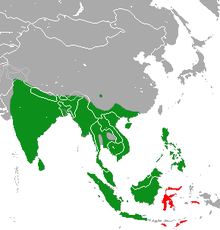 |
Size: Habitat: Forest, shrubland, and grassland[29] Diet: Primarily eats rats and fruit, as well as insects and molluscs[29] |
LC
|
| Brown palm civet
|
P. jerdoni Blanford, 1885 Two subspecies
|
 |
Size: 43–62 cm (17–24 in) long, plus 38–53 cm (15–21 in) tail[30] Habitat: Forest[31] Diet: Primarily eats fruit, as well as birds, rodents, and insects[31] |
LC
|
| Golden palm civet
|
P. zeylonensis Schreber, 1778 |
 |
Size: Habitat: Forest and shrubland[32] Diet: Primarily eats berries, fruits, and invertebrates, as well as small vertebrates[32] |
LC
|
Subfamily Viverrinae
| Common name | Scientific name and subspecies | Range | Size and ecology | IUCN status and estimated population |
|---|---|---|---|---|
| African civet
|
C. civetta Schreber, 1776 Six subspecies
|
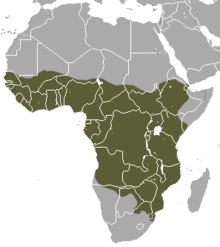 |
Size: 60–92 cm (24–36 in) long, plus 43–61 cm (17–24 in) tail[33] Habitat: Forest, savanna, shrubland, and inland wetlands[34] Diet: Omnivorous; primarily eats fruit[34] |
LC
|
| Common name | Scientific name and subspecies | Range | Size and ecology | IUCN status and estimated population |
|---|---|---|---|---|
| Large-spotted civet
|
V. megaspila Blyth, 1862 |
 |
Size: Habitat: Forest, shrubland, and inland wetlands[35] Diet: [35] |
EN
|
| Large Indian civet
|
V. zibetha Linnaeus, 1758 Five subspecies
|
 |
Size: Habitat: Forest and shrubland[36] Diet: Primarily eats fish, birds, lizards, frogs, insects, arthropods, and crabs, as well as poultry and rubbish[36] |
LC
|
| Malabar large-spotted civet
|
V. civettina Blyth, 1862 |
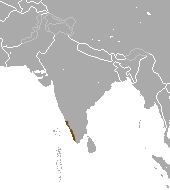 |
Size: Habitat: Forest and inland wetlands[37] Diet: [37] |
CR
|
| Malayan civet
|
V. tangalunga Gray, 1832 Two subspecies
|
 |
Size: long, plus 30–49 cm (12–19 in) tail[38] Habitat: Forest and shrubland[39] Diet: Omnivorous[39] |
LC
|
| Common name | Scientific name and subspecies | Range | Size and ecology | IUCN status and estimated population |
|---|---|---|---|---|
| Small Indian civet
|
V. indica Desmarest, 1804 Twelve subspecies
|
 |
Size: Habitat: Forest, savanna, shrubland, grassland, and inland wetlands[40] Diet: Primarily eats rodents, birds, snakes, fruit, roots, carrion, and insects[40] |
LC
|
Prehistoric viverrids
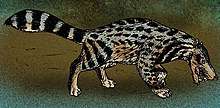
In addition to extant viverrids, a number of prehistoric species have been discovered and classified as a part of Viverridae. In addition to being placed within the extant subfamily Viverrinae, they have been categorized within the extinct subfamily Lophocyoninae, though most have not been classified within a subfamily. There is no generally accepted classification of extinct viverrid species. The species listed here are based on data from the Paleobiology Database, unless otherwise cited. Where available, the approximate time period the species was extant is given in millions of years before the present (Mya), also based on data from the Paleobiology Database.[41] All listed species are extinct; where a genus or subfamily within Viverridae comprises only extinct species, it is indicated with a dagger symbol ![]()
- Subfamily Lophocyoninae

- Genus Lophocyon

- l. paraskevaidisi
- Genus Lophocyon
- Subfamily Viverrinae (24 Mya–present)
- Genus Orangictis

- O. gariepensis (24–11 Mya)
- Genus Semigenetta

- S. cadeoti (17–15 Mya)
- Genus Viverra (7.3 Mya–present)
- V. leakeyi (Leakey's civet) (7.3–2.5 Mya)
- Genus Orangictis
- Unclassified
- Genus Africanictis

- A. hyaenoides (24–11 Mya)
- A. meini (24–11 Mya)
- A. schmidtkittleri (24–15 Mya)
- Genus Kanuites

- K. lewisae[42]
- Genus Ketketictis

- K. solida (24–15 Mya)
- Genus Leptoplesictis

- L. senutae (24–15 Mya)
- L. namibiensis (24–15 Mya)
- Genus Mioprionodon

- M. hodopeus (29–23 Mya)
- Genus Progenetta

- Genus Pseudocivetta

- Genus Sahelictis

- Genus Tugenicitis

- Genus Vishnuictis

- Genus Africanictis
References
- Gaubert, P.; Duckworth, J. W.; Do Linh San, E. (2016). "Genetta abyssinica". IUCN Red List of Threatened Species. 2016: e.T8994A45198149. doi:10.2305/IUCN.UK.2016-1.RLTS.T8994A45198149.en.
- Gaubert, P.; Fischer, C.; Hausser, Y.; Do Linh San, E. (2016). "Genetta angolensis". IUCN Red List of Threatened Species. 2016: e.T41696A45218468. doi:10.2305/IUCN.UK.2016-1.RLTS.T41696A45218468.en.
- Gaubert, P.; Do Linh San, E. (2015). "Genetta piscivora". IUCN Red List of Threatened Species. 2015: e.T15628A45201673. doi:10.2305/IUCN.UK.2015-4.RLTS.T15628A45201673.en.
- Gaubert, P.; Greengrass, E. J.; Do Linh San, E. (2015). "Genetta bourloni". IUCN Red List of Threatened Species. 2015: e.T136223A45220931. doi:10.2305/IUCN.UK.2015-4.RLTS.T136223A45220931.en.
- Gaubert, P.; Do Linh San, E. (2015). "Genetta tigrina". IUCN Red List of Threatened Species. 2015: e.T41702A45219459. doi:10.2305/IUCN.UK.2015-4.RLTS.T41702A45219459.en.
- Gaubert, P.; Carvalho, F.; Camps, D.; Do Linh San, E. (2015). "Genetta genetta". IUCN Red List of Threatened Species. 2015: e.T41698A45218636. doi:10.2305/IUCN.UK.2015-4.RLTS.T41698A45218636.en.
- Gaubert, P.; Angelici, F. M.; Do Linh San, E. (2015). "Genetta cristata". IUCN Red List of Threatened Species. 2015: e.T8998A45198406. doi:10.2305/IUCN.UK.2015-4.RLTS.T8998A45198406.en.
- Gaubert, P.; Dinets, V.; Do Linh San, E. (2016). "Genetta victoriae". IUCN Red List of Threatened Species. 2016: e.T41703A45219531. doi:10.2305/IUCN.UK.2016-1.RLTS.T41703A45219531.en.
- Gaubert, P.; Do Linh San, E. (2015). "Genetta thierryi". IUCN Red List of Threatened Species. 2015: e.T41701A45219325. doi:10.2305/IUCN.UK.2015-4.RLTS.T41701A45219325.en.
- Gaubert, P.; Do Linh San, E. (2016). "Genetta johnstoni". IUCN Red List of Threatened Species. 2016: e.T8997A45198265. doi:10.2305/IUCN.UK.2016-1.RLTS.T8997A45198265.en.
- Gaubert, P.; Do Linh San, E. (2015). "Genetta poensis". IUCN Red List of Threatened Species. 2015: e.T136435A45221269. doi:10.2305/IUCN.UK.2015-4.RLTS.T136435A45221269.en.
- Gaubert, P.; Do Linh San, E. (2016). "Genetta pardina". IUCN Red List of Threatened Species. 2016: e.T136437A45221360. doi:10.2305/IUCN.UK.2016-1.RLTS.T136437A45221360.en.
- Angelici, F. M.; Gaubert, P.; Do Linh San, E. (2016). "Genetta maculata". IUCN Red List of Threatened Species. 2016: e.T41699A45218948. doi:10.2305/IUCN.UK.2016-1.RLTS.T41699A45218948.en.
- Gaubert, P.; De Luca, D. W.; Rovero, F.; Do Linh San, E. (2016). "Genetta servalina". IUCN Red List of Threatened Species. 2016: e.T41700A97163789. doi:10.2305/IUCN.UK.2016-1.RLTS.T41700A97163789.en.
- Gillette, Corinna (2005). "Poiana richardsonii". Animal Diversity Web. University of Michigan. Retrieved April 16, 2020.
- Gaubert, P.; Do Linh San, E. (2015). "Poiana richardsonii". IUCN Red List of Threatened Species. 2015: e.T41704A45219609. doi:10.2305/IUCN.UK.2015-4.RLTS.T41704A45219609.en.
- Gaubert, P.; Do Linh San, E. (2015). "Poiana leightoni". IUCN Red List of Threatened Species. 2015: e.T44165A45220840. doi:10.2305/IUCN.UK.2015-4.RLTS.T44165A45220840.en.
- Timmins, R. J.; Coudrat, C. N. Z.; Duckworth, J. W.; Gray, T. N. E.; Robichaud, W.; Willcox, D. H. A.; Long, B.; Roberton, S. (2016). "Chrotogale owstoni". IUCN Red List of Threatened Species. 2016: e.T4806A45196929. doi:10.2305/IUCN.UK.2016-1.RLTS.T4806A45196929.en.
- Ross, J.; Wilting, A.; Ngoprasert, D.; Loken, B.; Hedges, L.; Duckworth, J. W.; Cheyne, S.; Brodie, J.; Chutipong, W.; Hearn, A.; Linkie, M.; McCarthy, J.; Tantipisanuh, N.; Haidir, I. A. (2015). "Cynogale bennettii". IUCN Red List of Threatened Species. 2015: e.T6082A45197343. doi:10.2305/IUCN.UK.2015-4.RLTS.T6082A45197343.en.
- Mathai, J.; Duckworth, J. W.; Wilting, A.; Hearn, A.; Brodie, J. (2015). "Diplogale hosei". IUCN Red List of Threatened Species. 2015: e.T6635A45197564. doi:10.2305/IUCN.UK.2015-4.RLTS.T6635A45197564.en.
- Ross, J.; Brodie, J.; Cheyne, S.; Chutipong, W.; Hedges, L.; Hearn, A.; Linkie, M.; Loken, B.; Mathai, J.; McCarthy, J.; Ngoprasert, D.; Tantipisanuh, N.; Wilting, A.; Haidir, I. A. (2015). "Hemigalus derbyanus". IUCN Red List of Threatened Species. 2015: e.T41689A45216918. doi:10.2305/IUCN.UK.2015-4.RLTS.T41689A45216918.en.
- Schleif, Molly (2013). "Arctictis binturong". Animal Diversity Web. University of Michigan. Retrieved April 16, 2020.
- Willcox, D. H. A.; Chutipong, W.; Gray, T. N. E.; Cheyne, S.; Semiadi, G.; Rahman, H.; Coudrat, C. N. Z.; Jennings, A.; Ghimirey, Y.; Ross, J.; Fredriksson, G.; Tilker, A. (2016). "Arctictis binturong". IUCN Red List of Threatened Species. 2016: e.T41690A45217088. doi:10.2305/IUCN.UK.2016-1.RLTS.T41690A45217088.en.
- Bauer, Chris (2013). "Arctogalidia trivirgata". Animal Diversity Web. University of Michigan. Retrieved April 16, 2020.
- Willcox, D. H. A.; Duckworth, J. W.; Timmins, R. J.; Chutipong, W.; Choudhury, A.; Roberton, S.; Long, B.; Hearn, A.; Ross, J. (2016). "Arctogalidia trivirgata". IUCN Red List of Threatened Species. 2016: e.T41691A45217378. doi:10.2305/IUCN.UK.2016-1.RLTS.T41691A45217378.en.
- Tasirin, J.; Dinets, V.; Meijaard, E.; Brodie, J.; Nijman, V.; Loffeld, T. A. C.; Hilser, H.; Shepherd, C.; Seymour, A. S.; Duckworth, J. W. (2015). "Macrogalidia musschenbroekii". IUCN Red List of Threatened Species. 2015: e.T12592A45198901. doi:10.2305/IUCN.UK.2015-4.RLTS.T12592A45198901.en.
- Lundrigan, Barbara; Baker, Steve (2003). "Paguma larvata". Animal Diversity Web. University of Michigan. Retrieved April 16, 2020.
- Duckworth, J. W.; Timmins, R. J.; Chutipong, W.; Choudhury, A.; Mathai, J.; Willcox, D. H. A.; Ghimirey, Y.; Chan, B.; Ross, J. (2016). "Paguma larvata". IUCN Red List of Threatened Species. 2016: e.T41692A45217601. doi:10.2305/IUCN.UK.2016-1.RLTS.T41692A45217601.en.
- Duckworth, J. W.; Timmins, R. J.; Choudhury, A.; Chutipong, W.; Willcox, D. H. A.; Mudappa, D.; Rahman, H.; Widmann, P.; Wilting, A.; Xu, W. (2016). "Paradoxurus hermaphroditus". IUCN Red List of Threatened Species. 2016: e.T41693A45217835. doi:10.2305/IUCN.UK.2016-1.RLTS.T41693A45217835.en.
- Bodle, Jessica (2013). "Paradoxurus jerdoni". Animal Diversity Web. University of Michigan. Retrieved April 16, 2020.
- Mudappa, D.; Choudhury, A.; Punjabi, G. A. (2016). "Paradoxurus jerdoni". IUCN Red List of Threatened Species. 2016: e.T16104A45201757. doi:10.2305/IUCN.UK.2016-1.RLTS.T16104A45201757.en.
- Duckworth, J. W.; Mudappa, D.; Pethiyagoda, R.; Woolgar, J.; de Silva Wijeyeratne, G.; Hall, J. (2016). "Paradoxurus zeylonensis". IUCN Red List of Threatened Species. 2016: e.T41694A45218119. doi:10.2305/IUCN.UK.2016-1.RLTS.T41694A45218119.en.
- Shalu, Tuteja (2000). "Civettictis civetta". Animal Diversity Web. University of Michigan. Retrieved April 16, 2020.
- Do Linh San, E.; Gaubert, P.; Wondmagegne, D.; Ray, J. (2019). "Civettictis civetta (amended version of 2015 assessment)". IUCN Red List of Threatened Species. 2019: e.T41695A147992107. doi:10.2305/IUCN.UK.2019-2.RLTS.T41695A147992107.en.
- Timmins, R.; Duckworth, J. W.; WWF-Malaysia, Roberton; S., Gray; T. N. E., Willcox; D. H. A., Chutipong; W., Long; B. (2016). "Viverra megaspila". IUCN Red List of Threatened Species. 2016: e.T41707A45220097. doi:10.2305/IUCN.UK.2016-1.RLTS.T41707A45220097.en.
- Timmins, R. J.; Duckworth, J. W.; Chutipong, W.; Ghimirey, Y.; Willcox, D. H. A.; Rahman, H.; Long, B.; Choudhury, A. (2016). "Viverra zibetha". IUCN Red List of Threatened Species. 2016: e.T41709A45220429. doi:10.2305/IUCN.UK.2016-1.RLTS.T41709A45220429.en.
- Mudappa, D.; Helgen, K.; Nandini, R. (2016). "Viverra civettina". IUCN Red List of Threatened Species. 2016: e.T23036A45202281. doi:10.2305/IUCN.UK.2016-1.RLTS.T23036A45202281.en.
- Lundrigan, Barbara; Harris, Julie (2000). "Viverra tangalunga". Animal Diversity Web. University of Michigan. Retrieved April 16, 2020.
- Duckworth, J. W.; Mathai, J.; Wilting, A.; Holden, J.; Hearn, A.; Ross, J. (2016). "Viverra tangalunga". IUCN Red List of Threatened Species. 2016: e.T41708A45220284. doi:10.2305/IUCN.UK.2016-1.RLTS.T41708A45220284.en.
- Choudhury, A.; Duckworth, J. W.; Timmins, R.; Chutipong, W.; Willcox, D. H. A.; Rahman, H.; Ghimirey, Y.; Mudappa, D. (2015). "Viverricula indica". IUCN Red List of Threatened Species. 2015: e.T41710A45220632. doi:10.2305/IUCN.UK.2015-4.RLTS.T41710A45220632.en.
- "Fossilworks: Viverridae". Paleobiology Database. University of Wisconsin–Madison. Retrieved April 16, 2020.
- Werdelin, Lars (2019). "Middle Miocene Carnivora and Hyaenodonta from Fort Ternan, western Kenya" (PDF). Geodiversitas. 41 (6): 267–283. doi:10.5252/geodiversitas2019v41a6.
_Genetta_abyssinica.png)
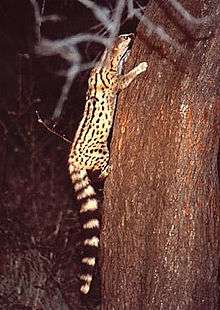
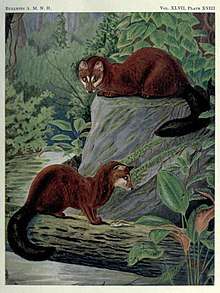
_(17356502041)_(crop).jpg)
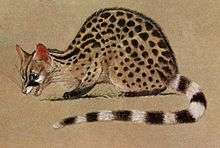


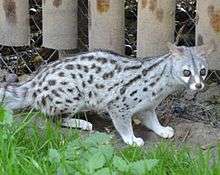
_(30556229264).jpg)

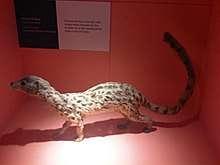

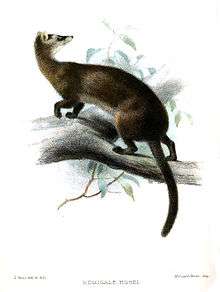
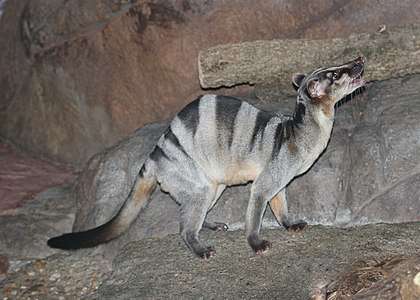
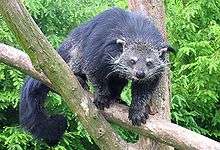
_(8076736823)_(cut).jpg)

.jpg)
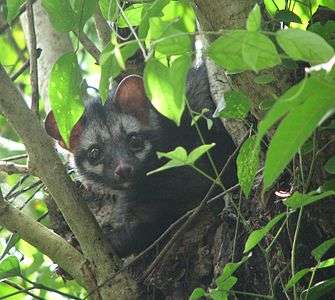


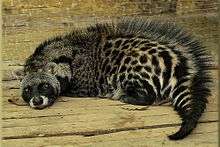

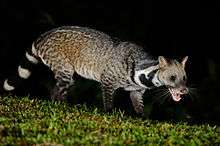
_DSCN2359_(cut).jpg)
